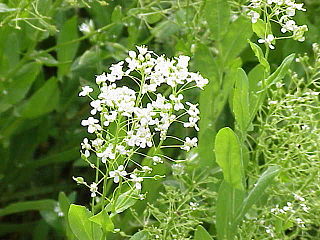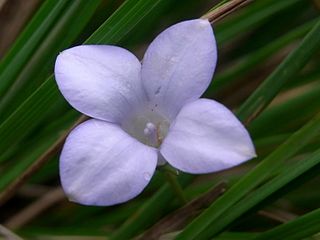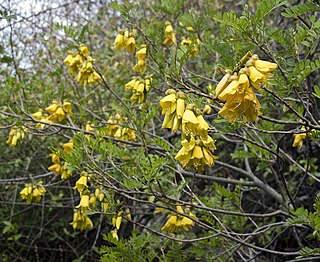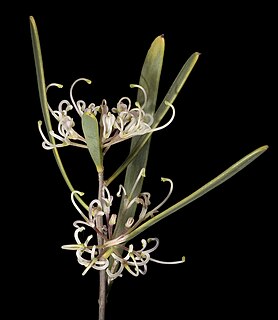
Lepidium is a genus of plants in the mustard/cabbage family, Brassicaceae. The genus is widely distributed in the Americas, Africa, Asia, Europe, and Australia. It includes familiar species such as garden cress, maca, and dittander. General common names include peppercress, peppergrass, pepperweed, and pepperwort. Some species form tumbleweeds. The genus name Lepidium is a Greek word meaning 'small scale', which is thought to be derived from a folk medicine usage of the plant to treat leprosy, which cause small scales on the skin. Another meaning is related to the small scale-like fruit.

Lepidium draba, the whitetop or hoary cress, or Thanet cress, is a rhizomatous perennial flowering plant in the family Brassicaceae. It is native to western Asia and southeastern Europe and widely introduced elsewhere.

Lepidium didymum, the lesser swine-cress, is a species of flowering plant in the family Brassicaceae.

Drypetes deplanchei is a tree of eastern and northern Australia. It also occurs in New Caledonia and Lord Howe Island. The genus is derived from the Greek, dryppa meaning "olive fruit". The species named after Dr. Emile Deplanche, who collected this plant at New Caledonia. Common names include yellow tulip, grey boxwood, white myrtle, grey bark and yellow tulipwood.

Hakea denticulata, commonly known as stinking Roger is a shrub tree endemic southern Western Australia. One of the many species of Australian plant described by the botanist Robert Brown. A compact shrub 1–2 m (3–7 ft) high and wide with red flowers in the spring with an unpleasant odour.

Alyxia squamulosa, commonly known as alyxia vine, is a species of shrub in the family Apocynaceae. It is endemic to Australia’s subtropical Lord Howe Island in the Tasman Sea. The specific epithet derives from the many bracteoles, or ‘scales’ that subtend the flowers. The plant previously known as Alyxia lindii is considered a taxonomic synonym of A. squamulosa, being reassigned in 2002.
Senecio howeanus is an annual, or short-lived perennial, herb in the daisy family, Asteraceae. The specific epithet refers to the type locality.
Rytidosperma unarede is a species of grass in the family Poaceae. The specific epithet is the Māori name unarede recorded by Raoul when the plant was first described in 1844.

Lepidium howei-insulae , commonly known as mustard & cress, is a flowering plant in the mustard and cabbage family. The specific epithet alludes to Lord Howe Island, where it is found.

Wahlenbergia insulae-howei is a flowering plant in the bellflower family. The specific epithet alludes to Lord Howe Island, where it is found.
Corokia carpodetoides, simply known locally as corokia, is a flowering plant in the Argophyllaceae family. The specific epithet derives from a resemblance to the genus Carpodetus, with the addition of the Latin suffix -oides (“resembling”).

Sophora howinsula, commonly known as lignum vitae or Lord Howe kowhai, is a flowering plant in the legume family. The specific epithet refers to the island to which the species is endemic.
Geniostoma petiolosum, commonly known as boar tree, is a flowering plant in the Loganiaceae family. The specific epithet refers to the relatively long and narrow petioles.
Elatostema grande is a flowering plant in the nettle family. The specific epithet alludes to the relatively large leaves and inflorescences.

Hakea ambigua is a shrub in the family Proteaceae. In favourable conditions may grow into an attractive weeping shrub with creamy white flowers. Only found in the Stirling Ranges of southern Western Australia.

Hakea stenophylla is a shrub or tree in the family Proteacea, with sweetly scented creamy-white flowers. It is endemic to Western Australia.

Hakea vittata, commonly known as the striped hakea, hooked needlewood, is a shrub of the family Proteaceae. Restricted to an area on the Eyre Peninsula and the Gawler Range in South Australia and small areas in eastern Victoria.

Lepidium coronopus,, is a species of flowering plant in the mustard family which is native to parts of Africa, western Asia and Europe, growing in shingle banks, wasteland or cultivated fields.

Hakea rostrata, common name beaked hakea, is a flowering plant in the family Proteaceae, native to South Australia and Victoria.

Hakea macrorrhyncha is a shrub in the family Proteaceae native to Australia. A restricted species of north-eastern New South Wales and south-eastern Queensland.














